
views
Getting the Soil Ready
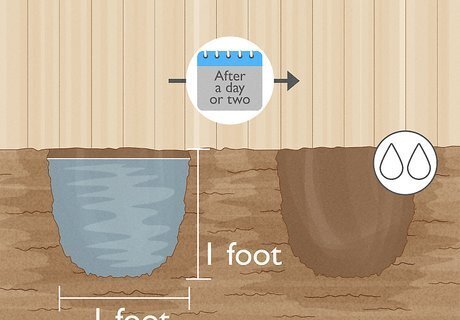
Select soil with naturally good drainage. Pomegranates don't have many soil requirements. Almost any type will do, but it needs to drain well. If you have clay-based soil or another type with poor drainage, replace it with a looser topsoil. A visual test is an easy way to check your soil's drainage. Dig a 1 foot (0.30 m) x 1 foot (0.30 m) hole in the ground, and wait until the soil in it is dry to the touch (this might take a day or more). Pour enough water into the hole to fill it up. If it takes more than a few hours for the water to drain out of the hole, then your soil has poor drainage.
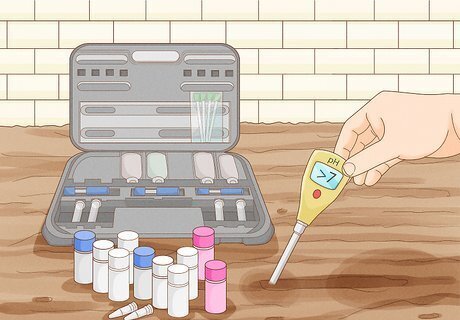
Test the soil’s pH. Pomegranates do well in moderately alkaline soil, with a pH a little above 7. However, they will also tolerate slightly acidic to neutral soils (pH 5.5-7). Buy a soil pH test kit from a garden store and check your soil to make sure it's somewhere in this moderate pH range.

Wait for warm weather. In a temperate zone, you can plan on sowing pomegranate seeds in spring after the last frost. In subtropical zones, late spring to early summer will be the optimum time. Pomegranates actually won't do well in tropical zones, since the weather there will be too humid.
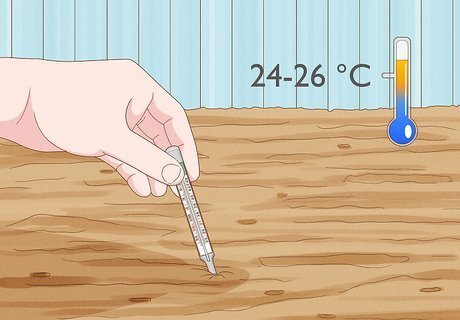
Check the soil temperature. Pomegranate seeds will germinate best in soil that is 24 °C (75 °F) to 26 °C (79 °F). If the air temperature isn’t mostly at or above these temperatures, use a soil thermometer to check the ground temperature. If your soil temperature is not up to this level, wait for warmer weather. You can get a head start by germinating your seeds indoors, however.
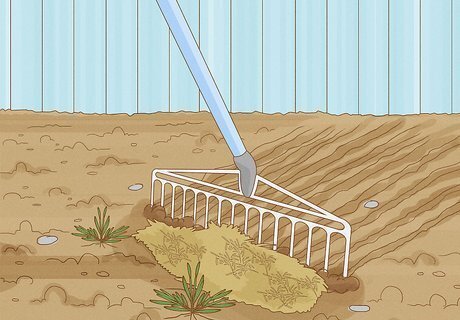
Till the soil. Run a stiff rake or a tiller over the area where you want to plant pomegranate trees. The goal is to remove any weeds, large rocks, or other debris, and to loosen up the soil so that it will be easier for the plants to grow. After debris is removed and clumps of dirt are broken, go over the soil again with a rake to even it out again.
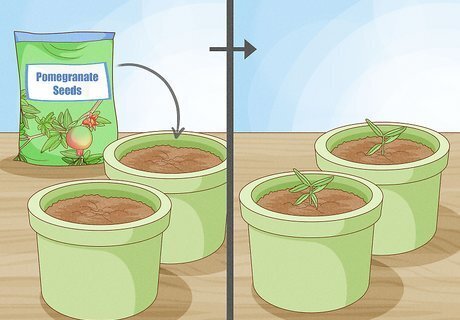
Start your seeds indoors instead if you want to get ahead. Germinating your seeds early and allowing them to reach seedling stage by the time warmer weather starts gives you a longer growing season. However, you’ll have to plant them in pots in regular potting soil and keep them indoors in a sunny area. You do not have to use special seedling containers if germinating your seeds indoors. Regular plant pots are just fine.
Treating the Seeds

Separate fresh seeds from the juice. You can germinate fresh pomegranate seeds, but it will take much longer of you don't separate them from the juice and rinse them well. Just lay the pomegranate pieces between two paper towels, and go over them with a rolling pin. Then, place the seeds in a colander and rinse them well. The juice will be absorbed by the paper towels, leaving the actual seeds separated. If you buy pomegranate seeds that are already separated from the juice and ready for planting, you can of course skip ahead to pre-soaking them.
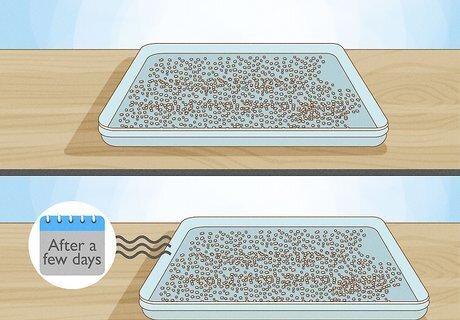
Dry the seeds. Remove them from the paper towel and spread them on a tray in a single layer. Let the seeds sit until they are dry to the touch. Let the seeds dry out for a few days.

Chill the seeds. Place the seeds, loosely covered, in the refrigerator. Let them stay there for a few weeks. This helps speed up germination by simulating the time the seeds would have spent in cooler ground during the winter before sprouting the next spring. If you are starting your seeds during the winter, then you can skip this part of the process.

Presoak the seeds. When you’re ready to germinate the pomegranate seeds, take them out and cover them with warm water in a dish. Leave them there overnight. You do not need to dry the seeds. They can be planted while they are still damp.

Place the seeds in a baggie. Another option for starting your seeds is to place them inside of a damp coffee filter and then place the filter inside of a plastic bag, such as a Ziploc sandwich baggie. Place the bag somewhere warm and check the seeds every few days. When the seeds start to sprout, transfer them to pots.
Sowing the Seeds
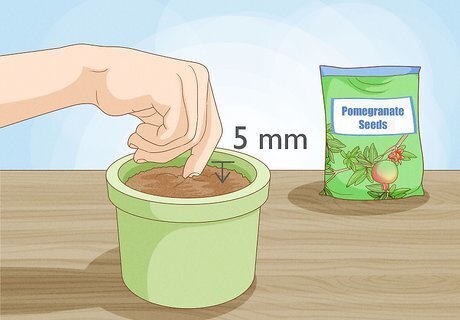
Put the seeds in the soil. Plant them at a depth of 5 millimetres (0.20 in). All you have to do is scatter the seeds over the soil in the ground outdoors, and slightly push them down or cover them with a thin layer of more soil. Don't worry about spacing at first. Later, you can remove seedlings so that only the strongest stay in the ground. If you are germinating the seeds in pots, you can plant several per pot, using regular potting soil. After they sprout, you can remove some to keep only the strongest seedlings. If you are using pots indoors, remember to keep them wherever they can get the most sun.

Keep the soil moist after sowing. Mist or lightly water the soil, but not so much that it’s soaking wet. The goal is to keep the seeds moist to help speed along the germination process.
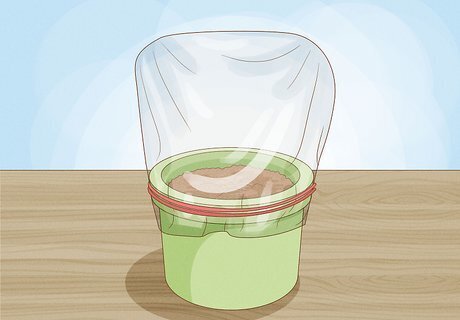
Cover indoor pots with a plastic bag. Loosely place a plastic bag over the pots just until the seeds sprout. This can help retain heat and moisture, speeding up the germination process. This can be especially helpful if you live in a cooler climate.
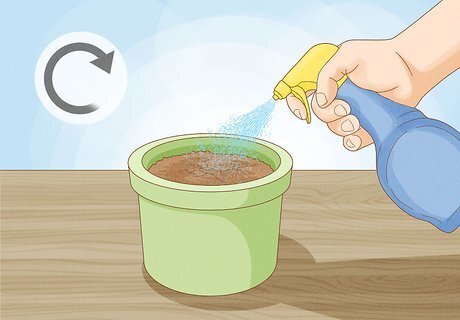
Monitor the soil regularly and water whenever necessary. At first, you may need to water your seeds every day to keep them moist. After the seeds germinate and sprout, you can gradually start watering less frequently. Eventually, once a week or so should be enough (less often if it rains).
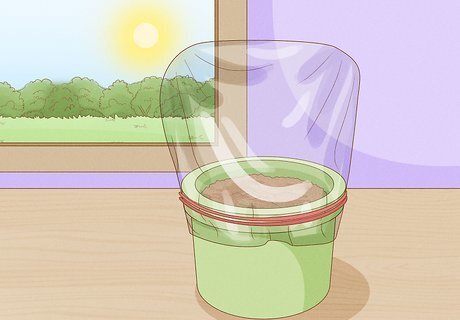
Give your pots time in the sun each day. If you started your seeds indoors, once the weather warms up a little, you can start moving the pots outside during the day while the sun is out. Then, bring them back in before the temperature drops at nightfall. As long as the danger of frost is over, it should be warm enough to give your pots some outside time.
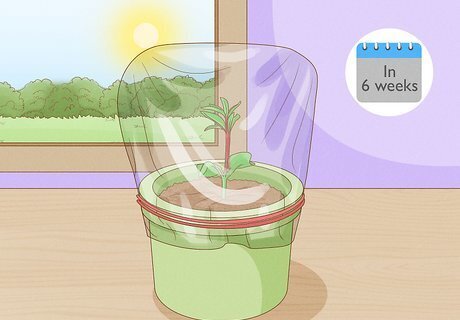
Wait for germination. In a temperate zone with a warm spring, the seeds will germinate in about six weeks. If you live in a slightly cooler or warmer area, your seeds may take a little less or a little more time.
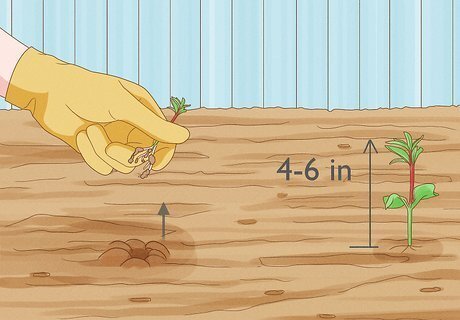
Space out seedlings planted in the ground. If you germinated your seeds in the ground, thin the seedlings out by the time they are 4 inches (10 cm) to 6 inches (15 cm) high. Pull any wilted or weak seedlings out of the ground, so that only healthy, vibrant ones remain. Leave only enough seedlings so that they will be 2-3 m (6-9 ft.) apart if you want the trees to form a hedge, or 5-6 m (15-18 ft.) apart if you want them to grow orchard-style.

Take the plants out of their pots once the weather is warm. If you germinated your seeds in pots, wait until they are 4 inches (10 cm) to 6 inches (15 cm) high. Simply choose a sunny spot and transplant them into the ground: Take the seedling and its entire root ball out of the pot. Gently remove some of the dirt that clings to the edges of the root ball. Dig a hole at the planting side that is larger than the root ball. Place the seedling's root ball in the hole, and carefully replace the dirt in the hole until it is completely filled and there is a small mound around the base of the seedling. Water the planting site and continue to monitor it.


















Comments
0 comment